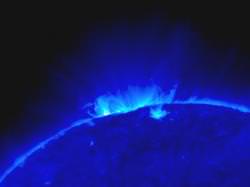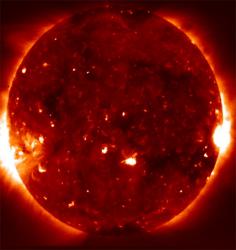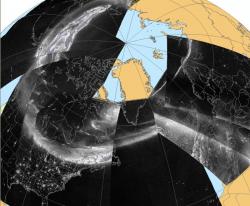 Remember the recent launch of the STEREO spacecraft? These are two identical solar observing spacecraft which will give astronomers a thrilling 3-D view of the Sun. Officially, they’re the Solar TerrEstrial RElations Observatories (STEREO… get it?), and they were lofted into orbit on October 25.
Remember the recent launch of the STEREO spacecraft? These are two identical solar observing spacecraft which will give astronomers a thrilling 3-D view of the Sun. Officially, they’re the Solar TerrEstrial RElations Observatories (STEREO… get it?), and they were lofted into orbit on October 25.
Continue reading “First Images of the Sun from STEREO”
Early Images of the Sun From Hinode
 The recently launched Japanese Hinode spacecraft is turning in some amazing new photographs of the Sun as part of its checkout phase.
The recently launched Japanese Hinode spacecraft is turning in some amazing new photographs of the Sun as part of its checkout phase.
Last Weekend’s Auroras… From Space
 Of course, as usual, we had rain here on Vancouver Island, Canada in December. But large portions of the Northern Hemisphere were treated to quite the sky show over the weekend – beautiful auroras stretched across the skies. All thanks to a powerful flurry of solar flares unleashed from the Sun last week.
Of course, as usual, we had rain here on Vancouver Island, Canada in December. But large portions of the Northern Hemisphere were treated to quite the sky show over the weekend – beautiful auroras stretched across the skies. All thanks to a powerful flurry of solar flares unleashed from the Sun last week.
Continue reading “Last Weekend’s Auroras… From Space”
Mercury’s Transit Captured by Hinode
The Japanese solar observing spacecraft Hinode captured this photograph of Mercury’s transit this week. Hinode, formerly known as Solar B, is currently in its shakedown period, where controllers ensure that each of its scientific instruments are working. But they couldn’t pass up this opportunity, so they pointed the spacecraft at the Sun, and watched the entire transit. Hinode should resume its normal science operations next month.
Continue reading “Mercury’s Transit Captured by Hinode”
Photos of Mercury’s Transit
I don’t know about you, but I wasn’t able to watch the Mercury transit directly. Fortunately, our hardworking friends in the Bad Astronomy/Universe Today Forum were outside with telescopes and cameras rolling. There are some still photographs, some mosaics of the transit, and some movies.
Continue reading “Photos of Mercury’s Transit”
Killer Solar Flare… on Another Star
NASA’s Swift satellite has spotted one of the most powerful stellar flares ever seen. Fortunately, this killer blast happened on a star located about 135 light-years from Earth. Had the flare occurred on the Sun, it would have triggered a mass extinction on our planet. The flaring star, II Pegasi, has a stellar companion in a very tight orbit. Their interaction has caused the tidally locked stars to spin very quickly. It’s this rapid rotation that leads to powerful stellar flares.
Continue reading “Killer Solar Flare… on Another Star”
First Light Looks Bright for Hinode
Japan’s newly-launched Hinode spacecraft has captured its first images of the Sun. Formerly known as Solar-B, the spacecraft launched on September 22, and opened its instruments to space on October 23, 2006. This image shows granules on the Sun’s surface, each of which is thousands of kilometres across. Over the course of the next month, mission controllers will continue to put the spacecraft through its paces. They expect to release their first scientific data in December.
Continue reading “First Light Looks Bright for Hinode”
Successful Liftoff for NASA’s STEREO Spacecraft
NASA’s solar-observing STEREO spacecraft were carried into space Wednesday evening, atop a Boeing Delta II rocket. STEREO, aka the Solar Terrestrial Relations Observatories, are two nearly identical observatories that will help construct 3-dimensional views of the Sun and its stormy environment. Over the next few months, the spacecraft will perform a series of maneuvers so that one travels ahead of the Earth in orbit, and another trails behind the planet. This will give a view of the Sun from two different vantage points.
Continue reading “Successful Liftoff for NASA’s STEREO Spacecraft”
Solar B Prepares for Launch
Solar flares are the most powerful explosions in the Solar System, releasing enormous energy in the form of radiation, high energy particles and magnetic fields. A new spacecraft, Solar B, developed by the Japanese Space Agency (JAXA) is set to launch on September 22, 2006, and will be able to detect these flares as they’re forming. The spacecraft will measure the movement of magnetic fields across the surface of the Sun, to help scientists predict when they will build up to a flare.
Continue reading “Solar B Prepares for Launch”
STEREO Spacecraft Set for Launch
Get set to see the Sun… in thrilling 3-D! At the end of August, NASA will launch its twin STEREO spacecraft into orbit around the Sun, to provide the first stereoscopic views of coronal mass ejections. The spacecraft will be lofted into space on Thursday, August 31, to begin a 2-year mission; one spacecraft will fly ahead of the Earth in its orbit, and the other will tail back. With this 3-D view, scientists will be able to accurately track the direction and speed of coronal mass ejections, providing much better space weather forecast.
Continue reading “STEREO Spacecraft Set for Launch”
